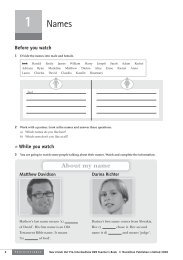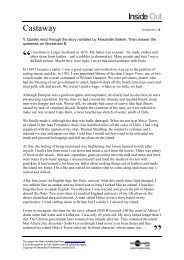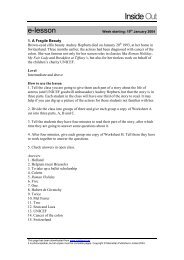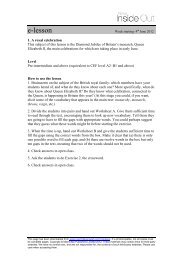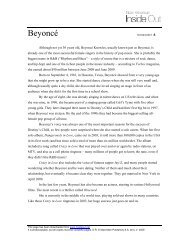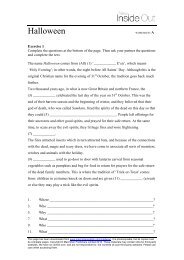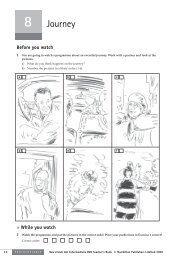5 Schooldays - Inside Out
5 Schooldays - Inside Out
5 Schooldays - Inside Out
You also want an ePaper? Increase the reach of your titles
YUMPU automatically turns print PDFs into web optimized ePapers that Google loves.
Optional extension<br />
To provide practice of family vocabulary ask the<br />
students to answer the following questions.<br />
a) Which two of the adults are related by birth?<br />
b) What are the relationships between the eight<br />
members of the two families?<br />
Example: Claire is Gillian’s daughter .<br />
1) Gillian is Tom’s and Luke and<br />
Connie’s .<br />
2) Jeff is Connie’s and Tom and Claire’s<br />
.<br />
3) Tom is Claire’s .<br />
4) Connie is Luke’s .<br />
5) Luke is Jeff’s .<br />
6) Tom and Luke are .<br />
7) John is Gillian’s and Pauline’s<br />
.<br />
8) Pauline is Jeff’s and John’s<br />
.<br />
Play Part 1 again if necessary so that they can check<br />
their answers.<br />
Part 3 (03:07–04:38)<br />
4 Ask the students to read the text and complete the<br />
school rules using the words in the box.<br />
a) stand f) hit<br />
b) smoking; walk g) lines<br />
c) wear h) move; ring<br />
d) gum i) hour’s<br />
e) arrive; uniform<br />
Ask the students to watch Part 3 and check their<br />
answers.<br />
Part 4 (04:39–06:18)<br />
5 Before watching Part 4, ask the students to read the<br />
sentences and guess the correct options. Then play<br />
the programme and tell the students to check their<br />
answers.<br />
a) enjoyed b) fast c) had to d) have to<br />
e) can sometimes f) will probably<br />
a) John and Jeff. They are brothers.<br />
b) 1) mother; aunt<br />
2) father; uncle<br />
3) brother<br />
4) sister<br />
5) son<br />
6) cousins<br />
7) husband; brother-in-law<br />
8) wife; sister-in-law<br />
If there is time, let the students watch the complete<br />
programme at the end so they can enjoy the<br />
whole film.<br />
After you watch<br />
6 Put the students into pairs and ask them to say what<br />
is similar and different in the parents’ and children’s<br />
experience of school.<br />
Part 2 (01:08–03:06)<br />
3 Give the students a few minutes to read through the<br />
statements. Then play Part 2 and tell the students<br />
to decide whether the statements are true or false.<br />
You could ask them to try and correct any false<br />
statements.<br />
a) T<br />
b) F (she did like her)<br />
c) F (it’s PE)<br />
d) T<br />
e) F (Connie doesn’t study dressmaking or<br />
shorthand and typing. However, she does<br />
study modern languages, geography and<br />
sport which Gillian didn’t study.)<br />
f) T<br />
g) T<br />
h) T<br />
Possible answers:<br />
Differences: punishments, meals, school<br />
subjects, school rules<br />
Similarities: homework, uniforms<br />
7 Put the students into groups and ask them to<br />
compare their own experiences with the people in<br />
the programme. Offer them examples from your<br />
own schooldays.<br />
30 P R O G R A M M E 5 <strong>Schooldays</strong>



